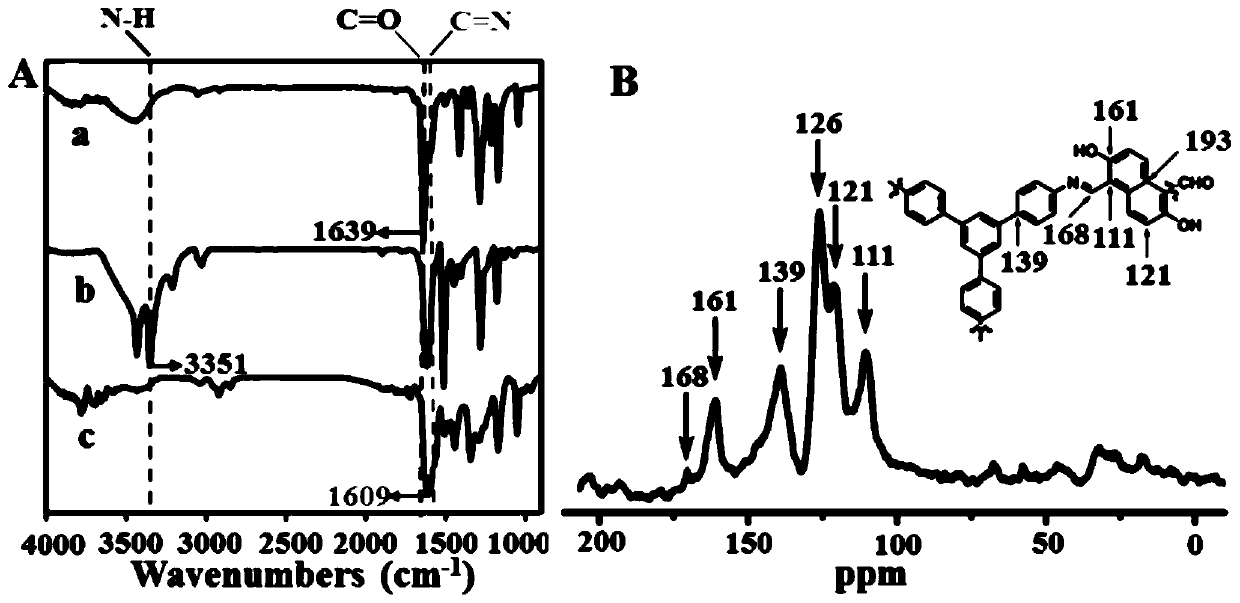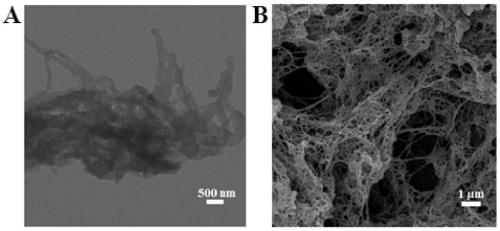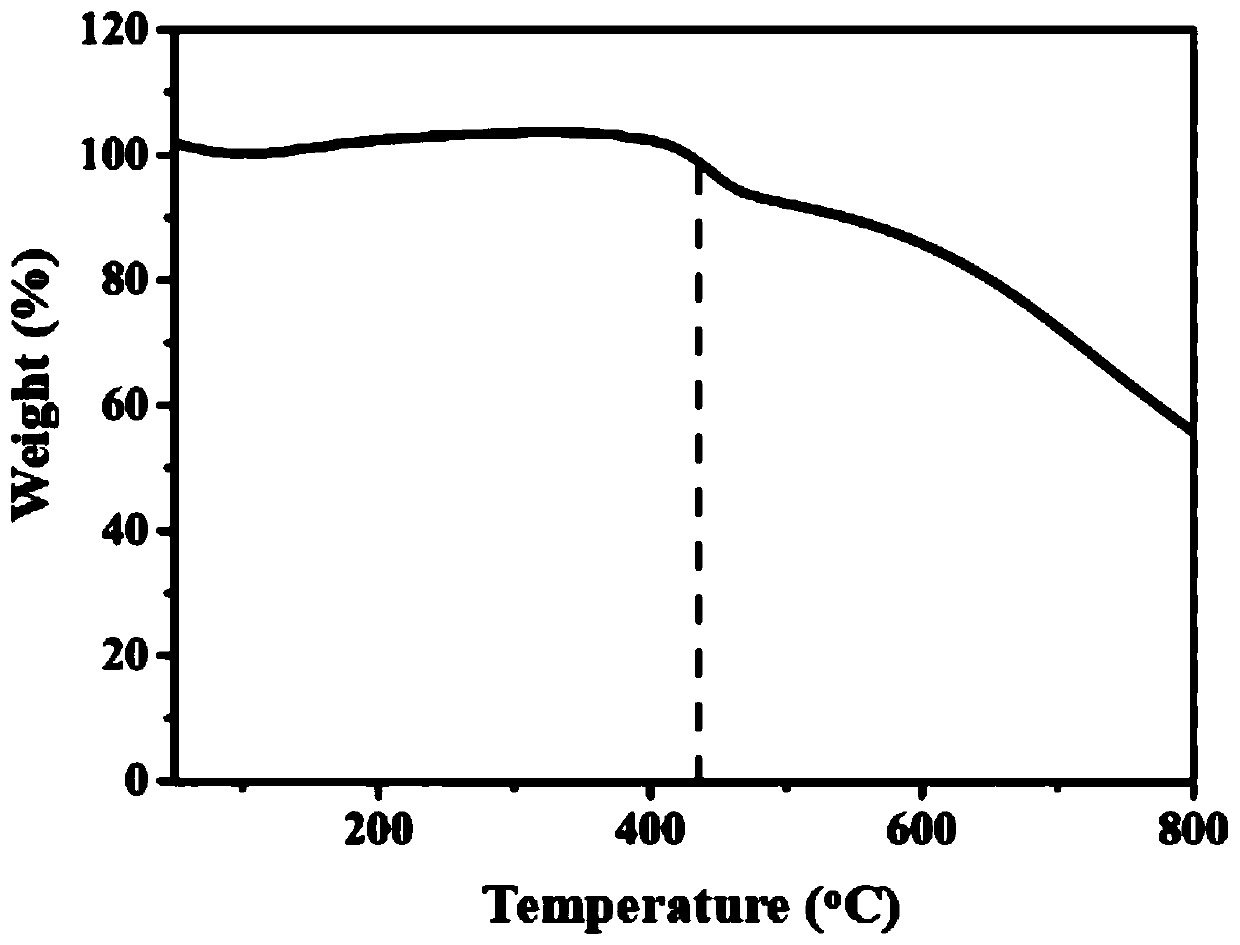A kind of covalent organic framework material and its preparation method and application in fluorescent sensor
A covalent organic framework, fluorescence sensor technology, applied in luminescent materials, analytical materials, fluorescence/phosphorescence, etc., can solve the problems of sensitivity and reusability, poor chemically unstable excitons migration, etc., and achieve excellent thermal stability. , excellent stability, high fluorescence intensity effect
- Summary
- Abstract
- Description
- Claims
- Application Information
AI Technical Summary
Problems solved by technology
Method used
Image
Examples
preparation example Construction
[0075] As mentioned above, COFs as chemical sensors need to have high emission efficiency, good crystallinity and chemical stability, but the corresponding exploration in these aspects is far from enough. Therefore, the present invention provides a covalent organic framework material, a preparation method thereof, and an application in a fluorescent sensor; the present invention will now be further described with reference to the drawings and specific embodiments.
[0076] It should be noted that, in the following examples, the reagents and consumables are as shown in Table 1, where, if there is no special label, all reagents are of analytical grade and are used directly without additional purification. The instrument is shown in Table 2.
[0077] Table 1
[0078]
[0079]
[0080] Table 2
[0081]
Embodiment 1
[0083] A method for preparing covalent organic framework materials (COFs-DT) includes the following steps:
[0084] 1. Preparation of DHNDA, including:
[0085] (1) Under magnetic stirring, use 15 mL of absolute ethanol to dissolve 1.65 g of paraformaldehyde and 0.03 g of NaOH;
[0086] (2) In a low-temperature cold bath, set the temperature to 0°C, add an aqueous solution of dimethylamine (the mass ratio of dimethylamine:NaOH is 100:1) into a 50mL round-bottomed flask, and step (1) finally obtains The solution was stirred for 0.5h. Then 3.3g of 2,6-dihydroxynaphthalene was dissolved in 21mL of absolute ethanol and added to the system, reacted for 1h; filtered with a funnel to obtain a white solid, washed the filter cake with absolute ethanol several times, and put the filter cake into vacuum drying Dry in the oven for 6 hours to obtain the intermediate product (Mannich base);
[0087] (3) Weigh 1.72g of the intermediate product Mannich base and 2.46g of hexamethylenetetramine, add ...
Embodiment 2
[0092] A method for preparing covalent organic framework materials (COFs-DT) includes the following steps:
[0093] 1. Preparation of DHNDA, including:
[0094] (1) Under magnetic stirring, dissolve 1.7 g of paraformaldehyde and 0.05 g of NaOH with 25 mL of absolute ethanol;
[0095] (2) In the low-temperature cold bath, set the temperature to 0°C, add the dimethylamine aqueous solution (the mass ratio of dimethylamine:NaOH is 90:1) into a 50mL round-bottomed flask, and step (1) finally obtains The solution was stirred for 0.5h. Then 5.75g of 2,6-dihydroxynaphthalene was dissolved in 40mL of absolute ethanol and added to the system, reacted for 1h; filtered with a funnel to obtain a white solid, washed the filter cake with absolute ethanol several times, and put the filter cake into vacuum drying Dry in the oven for 6 hours to obtain the intermediate product (Mannich base);
[0096] (3) Weigh 1.5g of the intermediate product Mannich base and 2.2g of hexamethylenetetramine, add them ...
PUM
| Property | Measurement | Unit |
|---|---|---|
| surface area | aaaaa | aaaaa |
| width | aaaaa | aaaaa |
Abstract
Description
Claims
Application Information
 Login to View More
Login to View More - R&D
- Intellectual Property
- Life Sciences
- Materials
- Tech Scout
- Unparalleled Data Quality
- Higher Quality Content
- 60% Fewer Hallucinations
Browse by: Latest US Patents, China's latest patents, Technical Efficacy Thesaurus, Application Domain, Technology Topic, Popular Technical Reports.
© 2025 PatSnap. All rights reserved.Legal|Privacy policy|Modern Slavery Act Transparency Statement|Sitemap|About US| Contact US: help@patsnap.com



